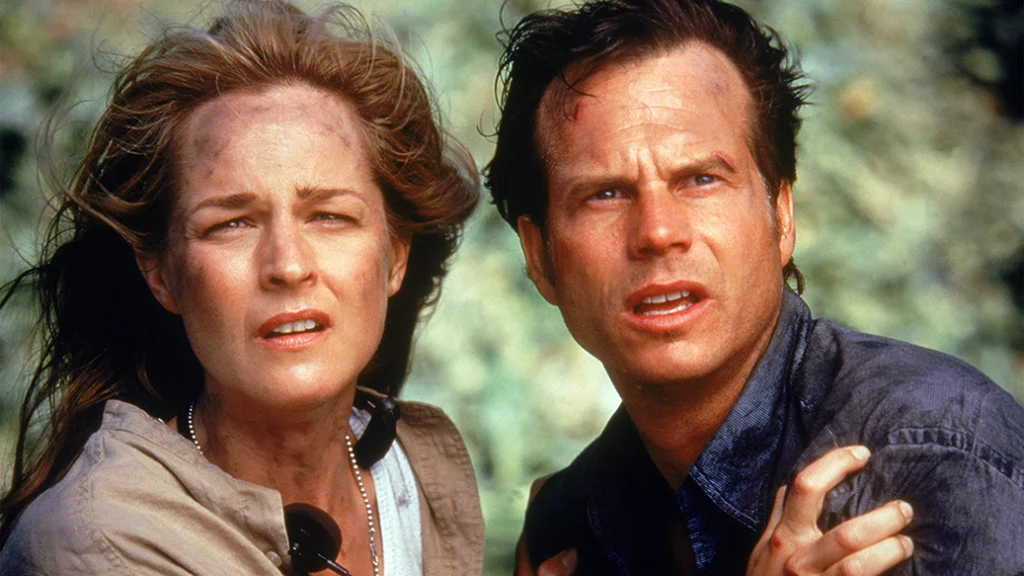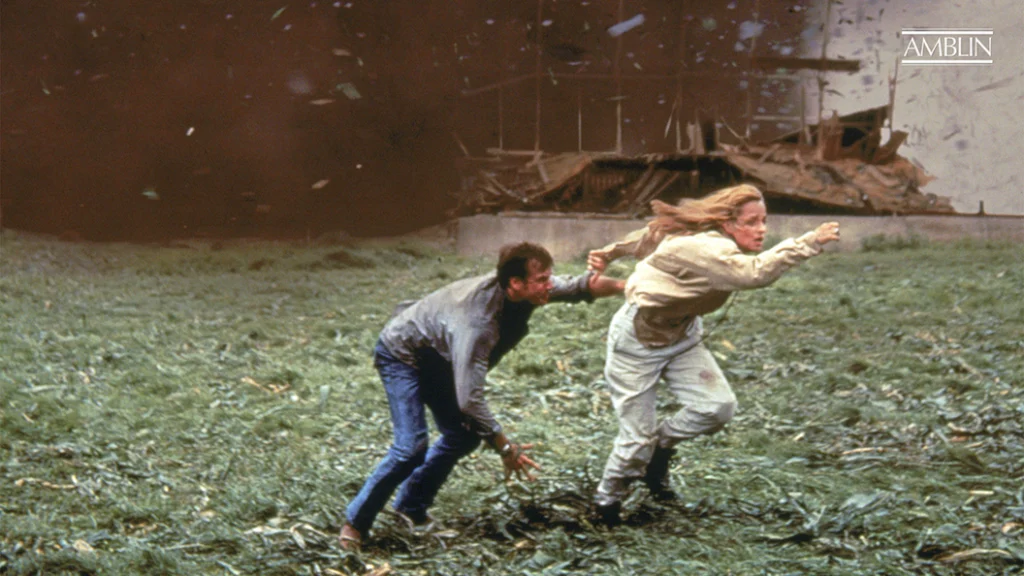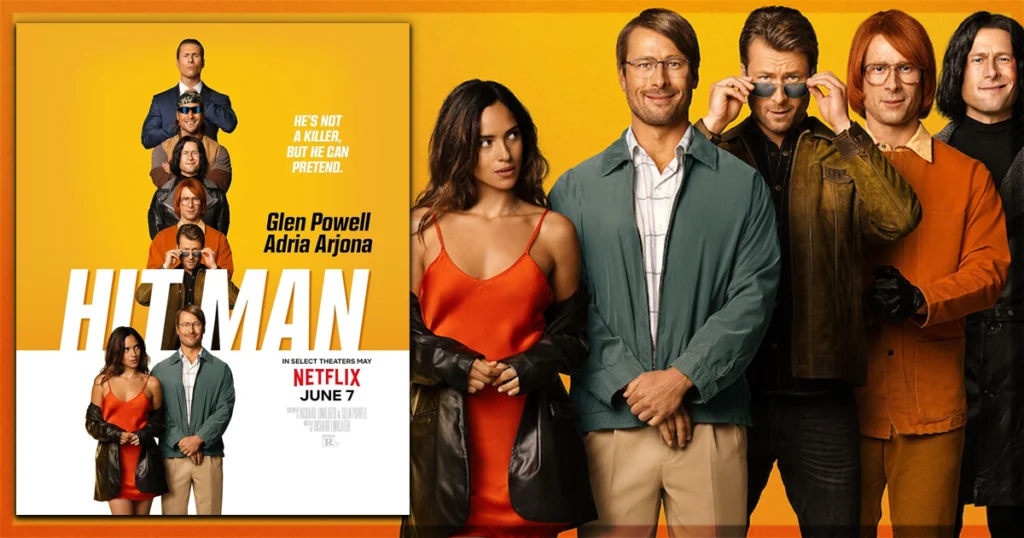With Twisters around the corner, what better time to revisit the 1996 original? Twister feels like an ancient relic in the modern day of cinema. The ’90s were stormed with disaster movies of all types, and sometimes, they had competing films releasing at once—for example, Deep Impact and Armageddon or Volcano and Dante’s Peak. Twister (like Independence Day) stood on its own. Mainly because it was so well executed. The cast, the writing, and even the marketing had a specialness. One cannot picture the movie without thinking about the iconic poster of Helen Hunt and Bill Paxton running from a pitch-black tornado tearing through a brown dusty sky.
Revisiting Twister after almost decades brought a new revelation to this writer. Somehow, the detail about Michael Crichton being a writer in this film vacated the memory. But if one sees Twister through the lens of Jurassic Park, it makes sense. Twister and Jurassic Park are almost the same movie, the difference being the F5 Tornado is the giant T-Rex about to destroy the exhibit.
Twister (1996) The story written by Michael Crichton and Anne-Marie Martin
Surprisingly, the film is more Spielberg-influenced than this writer remembers. At the heart of the story, written by Michael Crichton and Anne-Marie Martin, is divorce, a common theme in Spielberg’s filmography. The film produced by Spielberg’s banner Amblin was directed by Jan de Bont (Speed) and centers on a retired storm chaser named Bill (Bill Paxton), who tracks down his old group to have his ex-wife Jo (Helen Hunt) sign divorce papers. Jo is a fierce and impulsive chaser due to a past tragedy, and the film opens by showing the events that made her care about chasing storms.
When Bill finds the group, we are introduced to familiar acting faces such as Jeremy Davies, Alan Ruck (who had an iconic run on Succession), and an insanely loveable comedic performance from the late Philip Seymour Hoffman as Dusty. By the time Bill gets reacquainted with the group, the chasers are already on the brink of pursuing a string of storms. To make things more enticing for Bill to break retirement, Jo reveals Dorothy, an old invention she and Bill invented to study how tornadoes work. With “the extreme’s” return, they hope Dorothy will fly.

Twister and the influence of Amblin
One of the aspects that was not apparent to this reviewer in 1996 was the heavy influence of Spielberg throughout the film. In a sense, Twister can be seen as a harmonious collision of Jaws and Jurassic Park, only here, instead of sharks or dinosaurs, the wondrous threat is slowly escalating weather conditions. And adding to the Jurassic Park comparisons, the film opens with a death involving a monster sucking someone through a door. But in Twister, it’s an F5 tornado instead of a Velociraptor.
Much like those movies, Twister thematically discusses capitalism vs. science. In Jaws, the second antagonist is a town mayor refusing to close a beach amidst a growing threat; in Jurassic Park, the secondary antagonist is the park’s owner, John Hammond —a man who continually ignores Grant, Ellie, and Malcolm’s warnings about the dangers of resurrecting an extinct species.
In Twister, Cary Elwes’ character, Dr. Jonas Miller, is the capitalist take on storm chasing. He is the antithesis to Bill Paxton’s role, playing a storm chaser motivated by sponsorships rather than the science. In comparison, Paxton’s role as Bill is said to be a human weather barometer, able to predict changes without all the expensive gadgetry. Crichton’s signature writing is felt throughout the screenplay. Similar to Jurassic Park, he treats the Tornadoes like fantastical wonders. Both Jo and Bill marvel at the twisters as if they were ancient monsters of a bygone era. And at the same time, they respect the dangerous power they possess.
Story and stakes are communicated through character
A blockbuster film exhibiting strong character work feels like such a quaint idea these days. Yet, in the Summer of 1996, this was a crucial component in Hollywood. For all its silliness, Twister demonstrated that a simple spectacle could have a strong love for its characters. Helen Hunt did not get enough respect for her role as Jo. The death of Jo’s father visibly gave her trauma. It’s in Jo’s actions that we can sense the trauma that makes her reckless. Even so, the trauma pushes her to understand the magnificent weather monster that killed her father. Hunt does a tremendous job quietly communicating these characteristics. There’s no scene where she expresses the pain left over from Jo’s childhood. However, Jo’s grief is informed through Hunt’s performance and writing.
Philip Seymour Hoffman’s portrayal of Dusty is Twister’s strongest example of character work. Throughout the first half, Dusty is the comic relief. He gives the audience a reason to decompress after a thrilling sequence of tornado chasing. Hoffman plays the role with an overwhelming, lovable charm. To outsiders, he seems like an obnoxious goofball who does not take anything seriously. However, his demeanor is undoubtedly disarming in a Ted Lasso-type way. Dusty’s brilliance as a character is felt in the movie’s second half. For most of the film, Dusty is smiling, making jokes, and treating every dangerous moment like a trip to Six Flags. Then, during the iconic drive-in sequence, he switches.
His personality transition effectively conveys the emotional intensity of the moment. If our carefree and funny character is worried, the audience is too. If Twister was a film directed by Taika Waititi, the script might have included a humorous remark for Dusty in this scene, potentially undermining the necessary tension. However, through the writing and Hoffman’s performance, we understand that if Dusty is concerned, then the situation has become more serious.
The visuals hold up despite an absurd finale
Independence Day and Twister were released around the same time frame. Independence Day mostly holds together because of the strength of its cast. However, the special effects have waned in the decades since Will Smith punched an alien. Twister shockingly remains defiant in its depiction of tornadoes. One might assume the CGI would match a Syfy movie at this point, but they would be wrong. It’s another surprising commonality the movie shares with 1994’s Jurassic Park. The animators did a fantastic job capturing the intense power of an F5 tornado. Although we know it’s not real, the direction by Jan de Bont and the practical aspects added to the scene gives it a sense of realism. For example, there’s a surprising stunt where Paxton and Hunt drive through a collapsing house onto the road.

However, after all these years, this reviewer’s main critique of Twister is its ending. The film is captivating all the way through, but it concludes with an incredibly unrealistic finale where Bill and Jo survive the intense winds of an F5 tornado while strapped to a plumbing line. Even as a young viewer, this moment was hard to believe. Considering the movie’s attention to detail, this is the one creative choice that felt like the writers needed to gain more knowledge about these monstrous weather conditions.
Final Thoughts about Twister
Despite a finale that is a bit far-fetched, the movie Twister still holds up well, even though it’s almost three decades old. It has its silly moments, some of which are deliberately so. The flying cows are a good example. However, the trio of Hoffman, Hunt, and the always magnificent Bill Paxton keep everything grounded. Spielberg’s small influences and a screenplay co-written by Michael Crichton made it a timeless crowd-pleaser. The sequel has big shoes to fill, considering Paxton, Hoffman, and Crichton are no longer with us. But this reviewer is excited to see them try.
Twister was released in theaters in 1996. It is available to stream or buy on DVD.
Learn more about Twister at the Amblin website for the title.
You might also like…
‘Hit Man’ Cements Glen Powell’s Movie Star Status
‘Ted Lasso’ Retrospective – One Year Later



